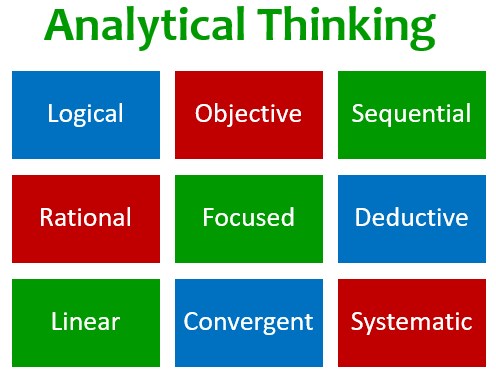Analytical Thinking
Analytical thinking is the process of examining and breaking down complex information in a systematic and logical way to resolve a problem. It involves separating a whole into its basic parts in order to examine the parts and their relationships.
Analytical thinking encompasses the following activities:
- Collecting relevant information
- Assessing the value of information
- Focusing on facts
- Eliminating extraneous information
- Dissecting information into simpler components
- Exploring connections and relationships
- Seeking patterns
- Studying trends
- Formulating theories
- Testing theories
- Conducting cause and effects analysis
- Examining variables and alternative possibilities
- Questioning results
- Developing possible solutions
- Evaluating solutions
Why use Analytical thinking?
Analytical thinking is used to dissect and study a problem in a logical manner to determine a practical answer or solution. It allows you to suspend judgment and apply deductive reasoning to find an answer based on logic and facts. If you do not use logical and objective thinking to analyze the problem, the solution you devise will not be based on logic. Instead, the solution may be based on simply intuition, instinct, and guessing.
About Analytical Thinking
Analytical Thinking is…
- Convergent
- Linear
- Deductive
- Sequential
- Logical
- Rational
- Focused
- Objective
- Systematic
The Analytical Thinking Process
Analytical thinking is processing information in a logical, step-by-step manner to find a solution to a problem. The process begins by gathering information then breaking that information down from a larger system of information into smaller parts. You examine those parts to find connections and relationships between them. This is done by looking for pattern or trends, and by conducting a cause and effect analysis. After you have assessed the individual parts, you formulate theories about the problem. You then test the theories to ensure your assessments of cause and effect are accurate. Finally, you develop and evaluate potential solutions to the problem.
Steps in the Analytical Thinking Process to Solve Problems
Gather Information
The first step in the analytical thinking process is gathering relevant information. This includes assessing the value of the information and eliminating extraneous information.
Break Down Information into Parts
After all relevant information is gathered, the next step it to break it down into smaller parts.
Examine the Parts to Find Connections and Relationships
After the information has been dissected into parts, examine the parts to find connections and relationships. Analyze the parts and variables to understand how they are connected and interact. Look for patterns and trends. Conduct a cause and effect analysis in a systematic manner to understand the variables and their relationships. This gets you to begin to think about different implications.
Formulate Theories
At this step you are making inferences from available information and drawing logical conclusions. Therefore, after you have thought about potential implications, formulate theories on what may happen as the variables change.
Test Theories
After you formulate theories, test those theories to confirm your understanding of issues and drivers behind the problem.
Develop Possible Solutions
After you understand the information, start to develop potential solutions. Use logic to create your solution.
Evaluate Solutions
After you have develop a few solutions, evaluate them to determine if they will solve the problem.
Related Links
Convergent and Divergent Thinking


